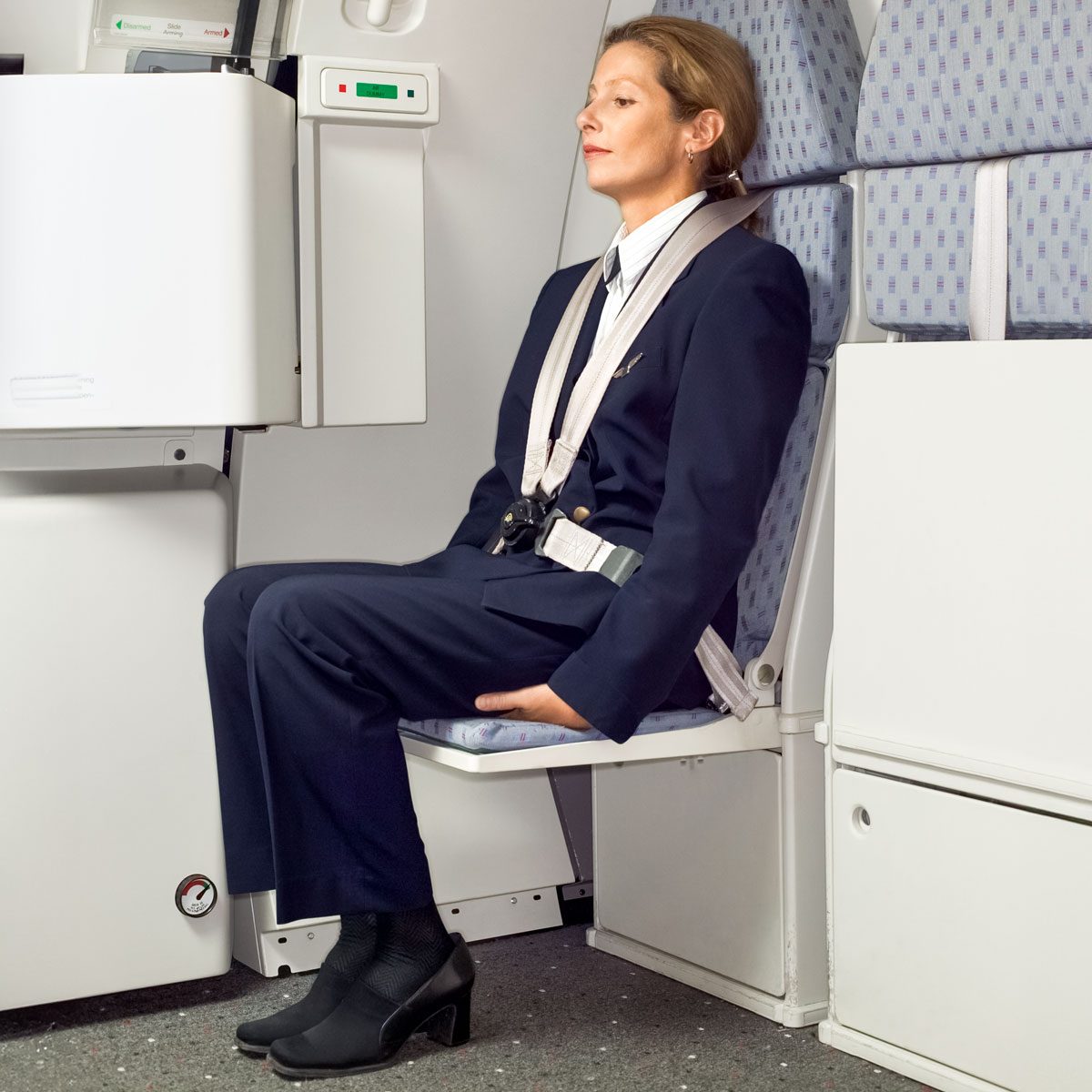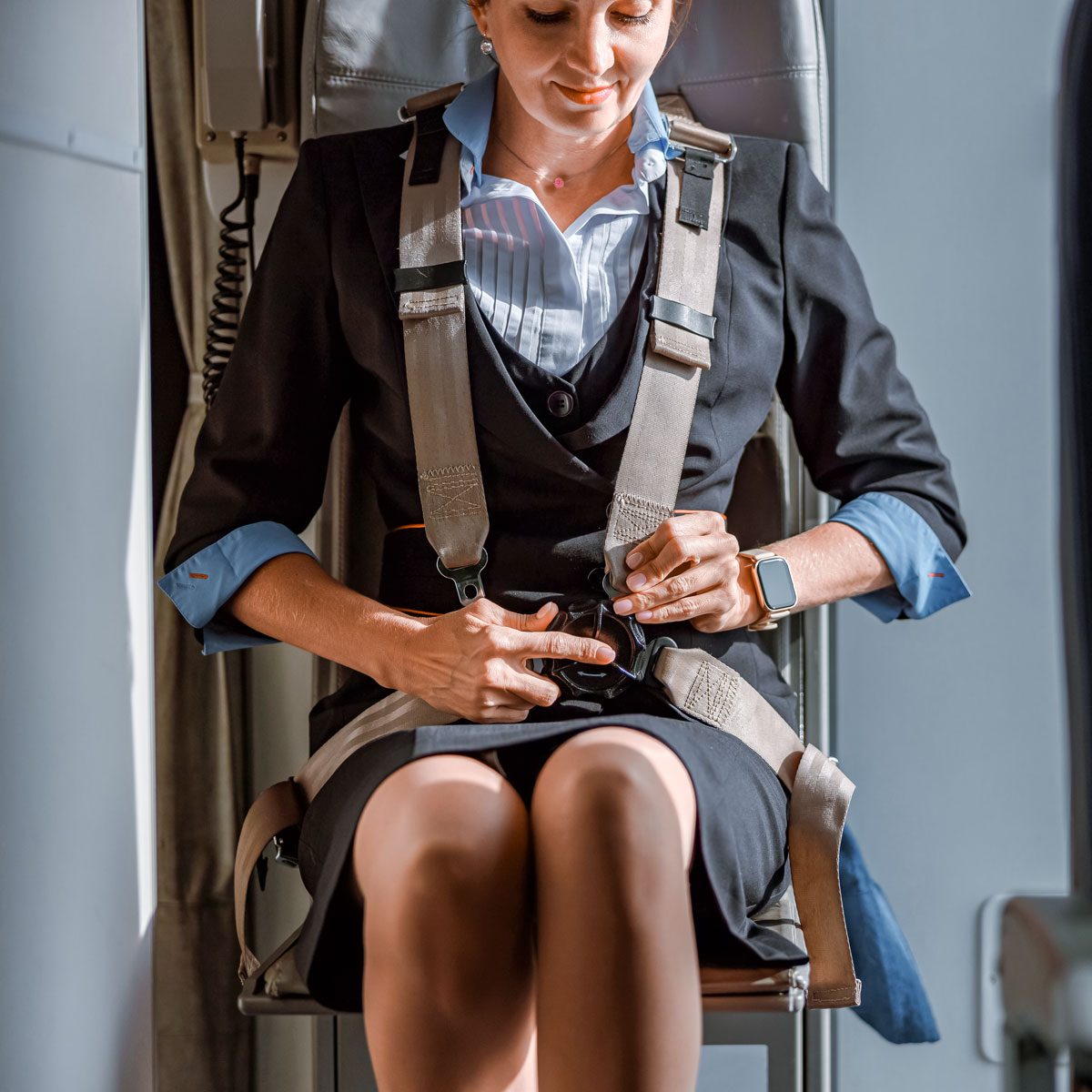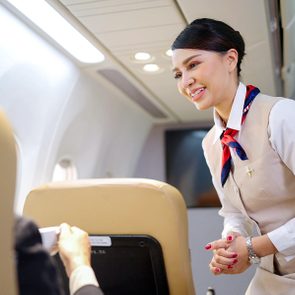Flight attendants have to sit in a very specific way for takeoff and landing. Here's why—and whether you should too.

Here’s Why Flight Attendants Might Sit on Their Hands During Takeoff and Landing

“Cabin crew, prepare for takeoff.” Have you ever noticed what flight attendants do right after this message from the cockpit? Always the professionals, they will take their seats, clasp their seatbelts and brace themselves, sometimes putting their palms under their thighs. But why do flight attendants sit on their hands?
“The position any and all flight attendants take for takeoff and landing is called the brace position, and while it may look a little unnatural to passengers, it does have a purpose,” says Cecily Anderson, a flight attendant with more than 20 years of experience working for three of the four biggest airline companies in the United States.
With the help of Anderson and another longtime flight attendant, we’re explaining what the brace position looks like and why flight attendants must sit that way. The answer is more practical—and surprising—than you might think.
Get Reader’s Digest’s Read Up newsletter for more travel, tech, cleaning, humor and fun facts all week long.
What does the brace position look like?
The brace position differs based on the type of plane, the type of jump seat and where the flight attendant is sitting. Here are a couple flying facts from official Federal Aviation Administration (FAA) guidelines:
- In forward-facing seats: A flight attendant should sit back in their seat, tighten their straps and rest their chin on their sternum. Their arms and hands should rest on their lap or hold on to the side of their seat. They should not hold on to their restraint system.
- In rear-facing seats: A flight attendant should sit back in their seat, rest their head against the seat back or headrest and have the restraint systems as tight as possible. Their hands should rest on their lap or hold on to the seat. They should not clasp their hands behind their head or hold on to their restraint system.
Erin Thomas, a veteran flight attendant with more than 15 years of experience who currently works for one of the major U.S. airlines, says she prefers to hold her hands on her lap. “I think it makes me look calm,” she says, “and passengers will feed off our energy, so if we’re calm during takeoff, they will be too.”
As for the position of the legs, there’s a trick there too: “We’re trained to not cross our legs and to keep our feet flat on the floor,” Anderson says.
Why is the brace position so important?

Anderson says that regardless of where flight attendants put their hands, the brace position is important “to protect ourselves in case of an emergency landing, such as a crash, skidding off the runway, things like that. We’re taught to always assume this position during takeoff and landing, no matter what.”
That’s because takeoff and landing are known as the critical phases and are considered the riskiest parts of a flight. This brace position is a vital safety measure—as the FAA notes, “the seated brace position is designed to reduce flailing and minimize secondary impact in case of an emergency.”
So why do flight attendants sit on their hands sometimes?
Flight attendants may assume the brace position by sitting on their hands, but that’s a matter of personal preference, not regulation. “We do need to position our hands properly as part of the brace position, and I guess you could sit on your hands if you want to. The flight-attendant rule is just that you can’t hold on to the harness,” Thomas says. “Being in the brace position is the important part.”
One popular internet theory says that sitting on the hands minimizes the “startle reflex” if there’s an emergency or unexpected turbulence. This reflex is a natural, instinctive reaction to sudden stimuli, but in high-anxiety situations like turbulence on a plane, it can lead to uncoordinated or delayed responses. By physically sitting on their hands, flight attendants ground themselves, maintaining composure and focus when it matters most.
Whether or not it’s an antidote to the so-called startle reflex, sitting on the hands isn’t a common practice on U.S. airlines. “I don’t believe I’ve seen any U.S.-based flight attendants sitting on their hands,” Anderson says. “I’ve worked for three major airlines and have never been trained to do so. I don’t know where this idea came from. Maybe in other countries, they do this?”
She may be on to something. We traced this piece of airplane trivia to a 2022 TikTok video posted by flight attendant Henny Lim, who flies with the Philippines-based airline Cebu Pacific. In the video, Lim demonstrates the brace position with her hands tucked under her thighs.
In short, hand position is personal. Thomas, for her part, says she would never sit on her hands because it might impede her ability to act quickly if something were to fall or if she suddenly needed to grab her seat for more support.
What other safety protocols do flight attendants keep in mind during takeoff and landing?
The brace position is just half of the process, Anderson says. “During this time, while assuming our brace position, we do what is called a silent 30-second review, where we go over emergency evacuation procedures in our heads,” she explains. “We scan for our nearest exit doors, whatever door we are mainly responsible for and go over our evacuation commands—what we would yell if we had an emergency to alert passengers.”
If flight attendants are standing when turbulence hits, they are advised to stand with their feet wide apart and hold on to a nearby seat or part of the aircraft to steady themselves. Ideally, the captain will announce upcoming turbulence so the flight attendants can return to their seats and strap in.
What’s the safest position for passengers while flying?
So should you brace yourself like a flight attendant? There’s no need for that, Thomas says. “On a normal flight, the safest passenger position is to stay seated with your seatbelt securely fastened,” she says. “If there’s turbulence, place both feet on the floor and hold on to your seat or armrests to steady yourself.”
However, if there is a true emergency, you will be instructed to assume the passenger brace position. Not sure what that looks like? (Hey, pay attention to the preflight safety briefing!) Here’s what to do:
- Bend forward.
- Place your head on or between your knees.
- Cover your head with your hands.
- Keep your feet flat on the floor for stability.
Now that you know what bracing looks like and what it means, you can rest assured that your flight attendants are ready and capable of quickly helping you in case of any in-flight emergency.
Why trust us
Reader’s Digest has published hundreds of travel stories that help readers explore the world safely, easily and affordably. We regularly cover topics such as the best places to visit (and the best times to visit them), tips and tricks to zoom through airport security, flight-attendant secrets, hotel-room hacks and more. We’re committed to producing high-quality content by writers with expertise and experience in their field in consultation with relevant, qualified experts. We rely on reputable primary sources, including government and professional organizations and academic institutions as well as our writers’ personal experiences where appropriate. For this piece on why flight attendants sit on their hands, Charlotte Hilton Andersen tapped her experience as a longtime journalist who specializes in etiquette, communication and flight-attendant protocols for Reader’s Digest. Read more about our team, our contributors and our editorial policies.
About the experts
|
Why trust us
Reader’s Digest has published hundreds of travel stories that help readers explore the world safely, easily and affordably. We regularly cover topics such as the best places to visit (and the best times to visit them), tips and tricks to zoom through airport security, flight-attendant secrets, hotel-room hacks and more. We’re committed to producing high-quality content by writers with expertise and experience in their field in consultation with relevant, qualified experts. We rely on reputable primary sources, including government and professional organizations and academic institutions as well as our writers’ personal experiences where appropriate. We verify all facts and data, back them with credible sourcing and revisit them over time to ensure they remain accurate and up to date. Read more about our team, our contributors and our editorial policies.
Sources:
- Cecily Anderson, flight attendant with a major U.S. airline; in-person interview, Jan. 16, 2025
- Erin Thomas, flight attendant with a major U.S. airline; phone interview, Jan. 18, 2025
- FAA: “218. Air Carrier Operations Bulletin No. 1-94-17”
- Henny Lim: “Why do cabin crew sit on their hands while in their jumpseats?”























